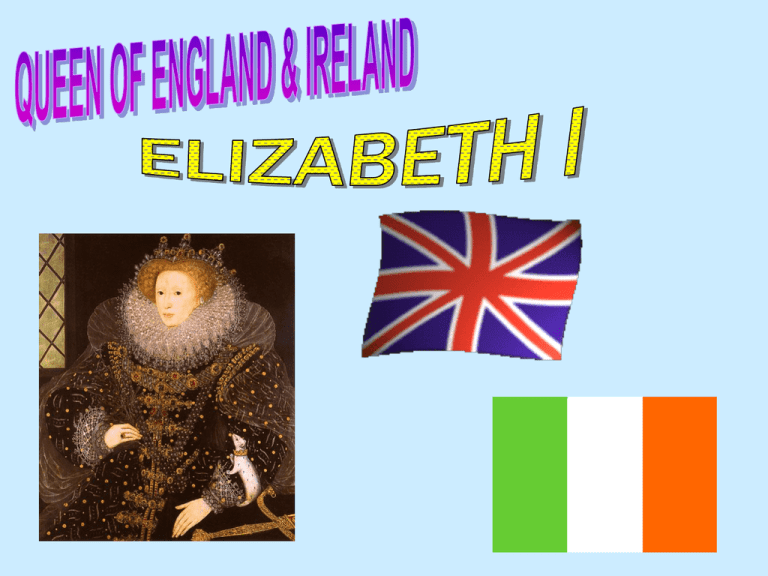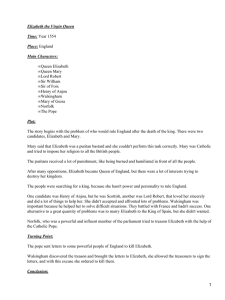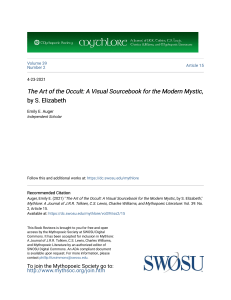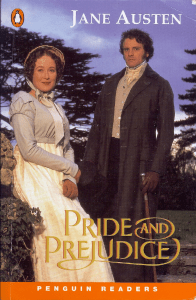Historia de Inglaterra
Anuncio

Reign:17 November 1558 – 24 March 1603 Coronation:15 January 1559 Predecessor:Mary I Successor:James I Real house:House of Tudor Father:Henry VIII Mother:Anne Boleyn Born:7 September 1533 Died:24 March 1603 Burial:Westminster Abbey Elizabeth I was Queen of England and Ireland from 17 November 1558 until her death. Many people called Elizabeth I The Virgin Queen (because she never married), Gloriana and Good Queen Bess. Elizabeth I was the sixth and final monarch of the Tudor dynasty. She reigned for 45 years during a period marked by increases in English power and influence worldwide. Elizabeth’s reign was referred to as the Elizabethan era or The Golden Ege of Elizabeth. Her favourite motto was video et taceo; In her nearly 45 years as monarch, she created only nine peerage dignities, one earldom and seven baronies in the Peerage of England, and one barony in the Peerage of Ireland. She also reduced the number of Privy Counsellors for thirty-nine to nineteen, and later to fourteen. Elizabeth was the only surviving child of King Henry VIII of England by his second wife, Anne Boleyn. Upon her birth, Elizabeth was heir presumptive to the throne of England despite having an older half sister, Mary; Mary wasn’t considered by Henry VIII to be a legitimate heir because Henry annulled his marriage to her mother, the Spanish princess Catherine of Aragon. Elizabeth, who was three years old when her mother died, was declared illegitimate and lost the litle of Princess. After Anne’s death, she was addressed as Lady Elizabeth and lived separately from her father as he married his succession of wives. In 1537, her father’s third wife Jane Seymour, gave birth to a son: Prince Edward. Elizabeth was resourceful, determined, and exceedingly intelligent. She loved learning for its own sake. Elizabeth did not live with her step-mother for long. Catherine died of puerperal fever after childbirth on 5 September 1548. Elizabeth was then moved to Hatfield. Mary I contracted a marriage with Prince Philip of Spain (later King Philip II), seeking to strengthen the Catholic influence in England. Following a moderate start to her reign, the Catholic Mary opted for a hard line against Protestants, whom she regarded as heretics and a threat to her authority. In November 1558, upon Queen Mary's death, Elizabeth ascended the throne. She was far more popular than Mary, and it is said that after Mary's death the people rejoiced in the streets. Legend has it Elizabeth was sitting beneath an oak tree reading the Greek Bible at Hatfield when she was informed of her succession to the throne. During her procession to the throne, she was welcomed wholeheartedly by the common people, who performed plays and read poetry exclaiming her beauty and intelligence. Elizabeth's coronation was on 15 January 1559. She was 25 years old. One of the most important concerns during Elizabeth's early reign was religion. Elizabeth ratified the Treaty of Cateau-Cambresis established on April 3 1559, bringing peace with France. She adopted a principle of "England for the English". Her other realm, Ireland, was dealt with differently. The English customs enforced in Ireland were unpopular with its inhabitants, as were her religious policies. Soon after her accession, many questioned whom Elizabeth would marry. Her reason for never marrying is unclear. There was also the story that she would only marry one man, Robert Dudley, 1st Earl of Leicester, with whom she was rumoured to be deeply in love and whom she appointed her Master of the Queen’s Horse Although Elizabeth is referred to as the "Virgin Queen", because she never married, it is unclear whether she was literally a virgin. While a King was expected to keep a mistress or concubine it would have been politically dangerous for a woman to behave in the same manner. The sexuality of the sovereign was as important to the national psyche then as in her father's time — though in a very different way. Playwright Ben Jonson remarked that the queen had "a membranum, and was incapable of Man" and that a friend, "a chirurgeon" had offered to remove the stubborn hymen with his trusty scalpel, but that Elizabeth demurred. Most prominent historians agree that she was a physical virgin because of a combination of psychological conditioning, avoidance of pregnancy and disease, threat of religious disfavor, possible spiritual consequences, and loss of political power. However, rumors of affairs abounded, one of the most enduring being with Robert Dudley, 1st Earl of Leicester. In 1575 she was closely associated with the Earl of Sild's teenage son who blossomed under her patronage and remained a loyal companion to her until her death. The Queen found a dangerous rival in her Catholic cousin Mary, Queen of Scots, who was the wife of the French King Francis II. In 1559, Mary had declared herself Queen of England with French support. In Scotland, Mary Stuart's mother, Mary of Guise attempted to cement French influence by providing army fortification against English aggression. Though Mary vehemently refused to ratify the treaty, it had the desired effect, and French influence was greatly reduced in Scotland. In France, meanwhile, conflict between the Catholics and the Huguenots led to the outbreak of the French Wars of Religion. Elizabeth secretly gave aid to the Huguenots. She made peace with France in 1564, agreeing to give up her claims to the last English possession on the French mainland, Calais, after the defeat of an English expedition at Le Havre. Catholicism had been restored under Mary I, but Elizabeth claimed to be Protestant, and thus wanted to create a Protestant Church. Parliament was summoned in 1559 to consider the Reformation Bill and to create a new Church. The Bill met heavy resistance in the House of Lords, as Catholic bishops as well as the lay peers voted against it. They butchered much of the Bill, changed the litany to allow for a transubstantial belief in the Communion and refused to grant Elizabeth the title of Supreme Head of the Church. The Act of Supremacy confirmed Elizabeth as Supreme Governor of the Church of England, as opposed to the Supreme Head. Supreme Governor was a suitably equivocal phrasing that made Elizabeth head of the church without ever saying she was, important because in the sixteenth century, it was felt that women could not rule a church. After Parliament was dismissed, Elizabeth, along with William Cecil, drafted what are known as the Royal Injunctions. Elizabeth never changed the Religious Settlement despite Protestant pressure to do so and it is in fact the 1559 Settlement that forms much of the basis of today's Church of England. In 1579, the Second Desmond Rebellion began in Ireland with the arrival of an invading force funded by Pope Gregory XIII; but by 1583, the rebellion had been put down after a brutal campaign waged by fire, sword and famine, in which a large part of the population of the then County Desmond, the north-western part of the province of Munster died. Also in 1580, Philip II annexed Portugal, and with the Portuguese throne came the command of the high seas. After the assassination of the Dutch Stadholder William I, England began to side openly with the United Provinces of the Netherlands, who were at the time rebelling against Spanish rule. Mary was put on trial for treason by a court of about 40 noblemen, including Catholics, presided over by England's Chief of Justice, Sir John Popham. Mary denied the accusation, and remonstrated that she was denied the opportunity of reviewing the evidence or her papers that had been removed from her, that she had been denied access to legal counsel and that she had never been an English subject and therefore could not be convicted of treason. Mary had left Philip her claim to the English throne; under force of the threat from Elizabeth's policies in the Netherlands and the East Atlantic, Philip set out his plans for an invasion of England. In April 1587, Sir Francis Drake burned part of the Spanish fleet at Cádiz, delaying Philip's plans. In July 1588, the Spanish Armada, a grand fleet of 130 ships bearing over 30,000 men, set sail in the expectation of conveying a Spanish invasion force under the command of the Duke of Parma across the English Channel from the Netherlands. The Spanish attempt was defeated by the English fleet under Lord High Admiral Charles Howard, 2nd Baron Howard of Effingham, aided by inclement weather. The Armada was forced to return to Spain, with appalling losses on the North and West coasts of Ireland. The victory tremendously increased Elizabeth's popularity, but it proved far from decisive, and an ambitious strike against Spain in the following year ended in complete failure. Elizabeth sent a further 2,000 troops to France after the Spanish took Calais. Then she authorised an attack on the Azores in 1597, but the attempt was a disastrous failure. Further battles continued until 1598, when France and Spain finally made peace. The Anglo-Spanish War reached a stalemate after Philip II died later in the year. In part because of the war, Raleigh and Gilbert's overseas colonisation attempts came to nothing, and the English settlement of North America was stalled, until James I negotiated peace in the Treaty of London, 1604. This period had begun with the repulsion of the Spanish Armada, which secured Elizabeth's authority as a Protestant monarch; it ended with the melancholy of old age and the increasing cynicism of a Court that had grown stale. The Queen's health remained good until the autumn of 1602, when a series of losses among her remaining friends appeared to throw her into a melancholy. In her depression, she was lethargic and silent, quite unlike her usual brisk manner. Her behaviour became eccentric. She stood upright, without relief, for two days, silent, with her finger held in her mouth like a tired child. It was as if she knew that, lying down, she would not rise again. The will of Henry VIII had declared that Elizabeth was to be succeeded by the descendants of his younger sister, Mary Tudor, Duchess of Suffolk, rather than by the Scottish descendants of his elder sister, Margaret Tudor. If the will were upheld, then Elizabeth would have been succeeded by Lady Anne Stanley. Elizabeth's death on March 24, 1603; heralding the end of the Tudor Dynasty and the start of the reign of the House of Stuart in the Kingdom of England. James I's proclamation broke precedent because it was issued not by the new sovereign himself but by a Council of Accession, as James was in Scotland at the time. Elizabeth I used the official style "Elizabeth, by the Grace of God, Queen of England, France and Ireland, Fidei defensor, etc." Whilst most of the style matched the styles of her predecessors, Elizabeth I was the first to use "etc.". Elizabeth's arms were the same as those used by Henry IV: Quarterly, Azure three fleurs-de-lys Or (for France) and Gules three lions passant guardant in pale Or (for England). Whilst her Tudor predecessors had used a gold lion and a red dragon as heraldic supporters, Elizabeth used a gold lion and a gold dragon. Elizabeth adopted one of her mother's mottoes, Semper Eadem. http://es.wikipedia.org/wiki/Imagen:Elizabeth1England.jpg http://es.wikipedia.org/wiki/Imagen:Elizabeth_I_of_England_-_coronation_portrait.jpg http://www.sitographics.com/enciclog/banderas/europa/image/irlanda.gif http://en.wikipedia.org/wiki/Image:PrincessElizabethTudor.jpg http://www.delsolmedina.com/Afotos/CoronaIsabelM.jpg http://www.dec.ufcg.edu.br/biografias/rbeliz01.jpg http://www.almargen.com.ar/wp-content/imagenes/2006/07/mapa_escocia.jpg http://www.worldflags.es/ampliaciones/322aESPANA%201978XS.jpg http://www.latercera.cl/showjpg/0,,1_158595418_165,00.jpg http://www.ciudadrealiman.com/WEB2001/WEBTIENDA/fotos/ARMAS/Ballesta.JPG http://spanish.khukriwala.com/pcat-gifs/categories/axes-ind.jpg


